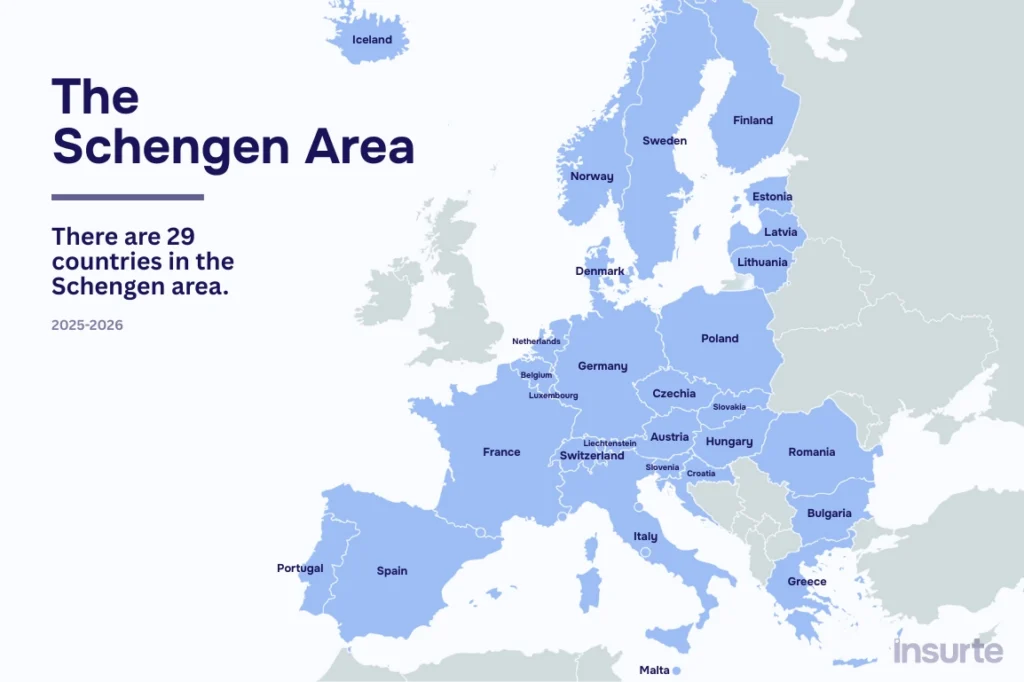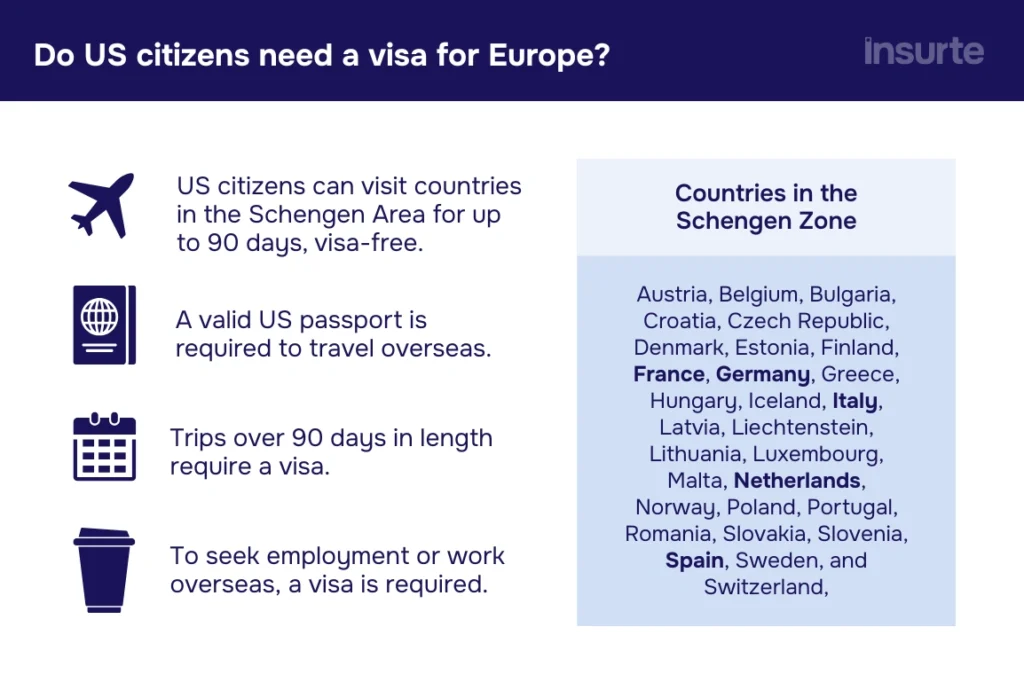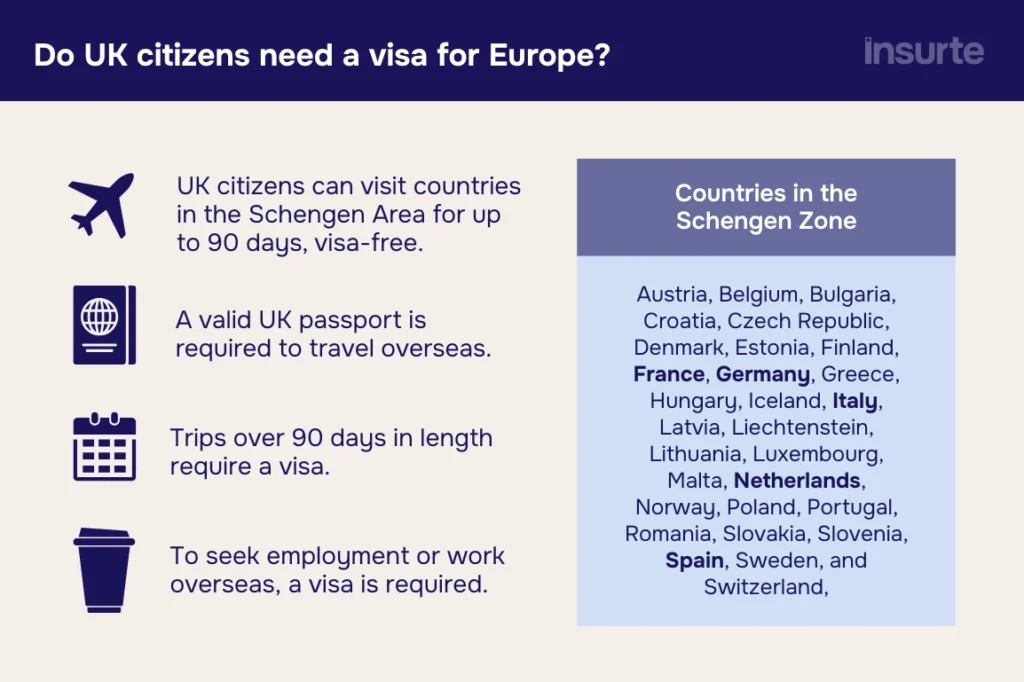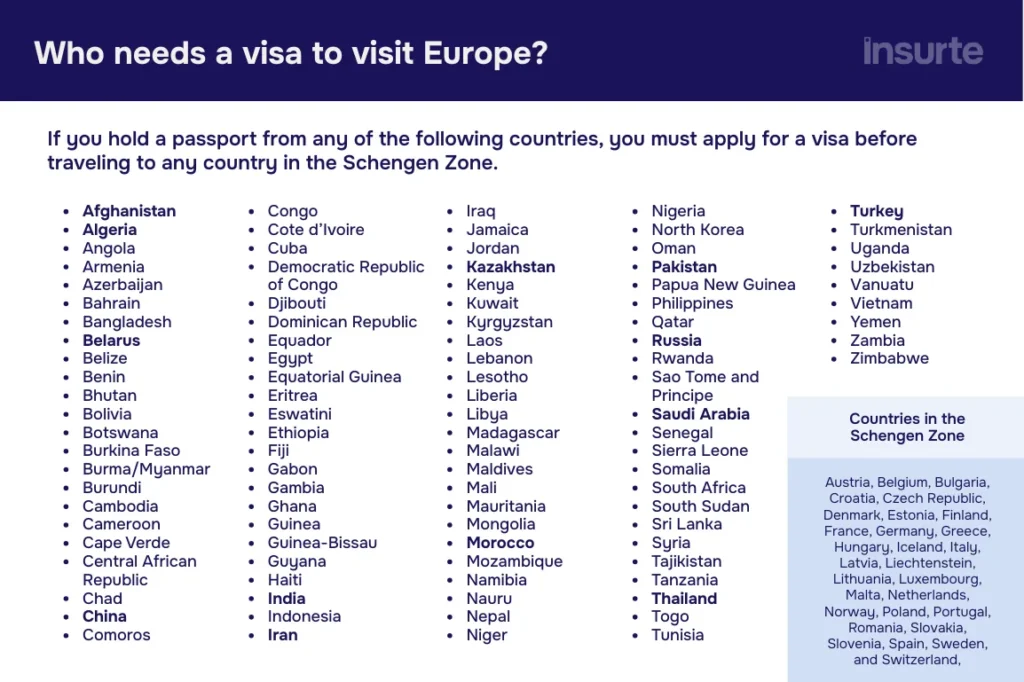Home > How to Travel to the Schengen Area in 2026
How to Travel to the Schengen Area in 2026
Whether you're a US citizen, UK citizen, or traveler from another country, it's really important to know what the rules of entry are for countries in the Schengen zone (for instance, Schengen visa travel insurance - pssst...it's mandatory).
Understanding what's required before you head off will save you from a headache waiting to happen.
If you don't meet the entry requirements, you may not be allowed to depart at the gate or may even be denied entry at the border.
The Schengen area (which includes 29 different countries in Europe) has specific rules about how travelers can enter and pass through, as well as how long they're allowed to stay.
While the rules are specific, they're relatively easy to understand. In this guide, we're going to give you the must-know information so you can start planning your trip to Europe, worry-free!

What is the Schengen area
The Schengen area (also called the Schengen zone or Schengen space) is a group of European countries that have decided to allow free movement between them.
This means that people in the area, whether they're citizens, residents, or just passing through, can move from country to country without needing to pass through border control each time.
Most of the countries in the European Union are also in the Schengen area, but not all of them. Additionally, the United Kingdom isn't part of the EU nor the Schengen zone.
One thing that's helpful to know about the Schengen area is that it isn't a geographical area. It's a geopolitical one, meaning countries in the Schengen zone don't need to share physical borders.
Traveling to the Schengen Area soon?
Make sure you get your Schengen-compliant travel insurance ahead of time ✈️
Schengen visa requirements
Many people need a visa to go the Schengen zone, regardless of which country or countries they're planning to visit. Whether or not you need one mainly depends on two things: your nationality and the length of your stay.
Here's how the rules break down for different nationalities:

Schengen visa applicants from the US
US citizens
If you're a US citizen, you can travel to the Schengen area for up to 90 days (within a 180-day period) for tourism or business without needing a visa.
However, starting in 2026, US travelers will have to apply for an ETIAS (European Travel Information and Authorization System) before their trips. ETIAS isn't a visa; it's a pre-travel authorization.
ETIAS, for all intents and purposes, is permission to enter the zone.
Most applicants will be approved within just a couple of minutes, and getting your ETIAS is a fully online process.
If you're a US citizen and are planning to spend more than 90 days in the Schengen zone, on the other hand, you need to apply for the appropriate visa, not ETIAS.
US residents
If you live in the US legally, but are not a US citizen, you may need a visa to travel to Europe.
This is because visa exemption isn't dependent on your residency (where you live), it's dependent on your nationality, i.e., the country that issued your passport.
If you hold a passport from China, India, South Africa, and several other countries, you will need a visa to visit the Schengen area, even if you live in the US as a legal resident.

Schengen visa applicants from the UK
UK citizens
Since Brexit, UK citizens, unfortunately, no longer enjoy free movement across Europe. If you're a UK passport holder, you can travel to the Schengen zone for up to 90 days in a 180-day period without a visa. For longer stays or work, you’ll need to apply for a visa.
If you’re traveling to the Schengen area without a visa (such as for a short stay), you will need to apply for travel authorization with ETIAS from 2026 on.
UK residents
If you are not a British citizen, but live in the UK legally, you may need a visa to travel to the Schengen area.
As mentioned above for US residents, whether or not you need a visa depends on your nationality, not your legal residency.

Schengen applicants from other nations
If you’re from a country that requires a visa to enter the Schengen area, like India or China, you need to apply for a Schengen visa before your trip.
The application process involves putting together several different documents, like a travel itinerary, proof of accommodation, proper insurance, proof of funds, and other documents that are required by the Schengen area.
You can apply for a Schengen visa through a visa application center for the country you’ll arrive in first. If there isn’t a visa center in your country, you may need to apply through a consulate or embassy’s consular section.
The entire process takes a few weeks (sometimes more if you are applying during peak season or applications are heavy at the moment), and depending on which visa specifically you're applying for.
When applying for your visa, you'll need to present all of the following documents. In some cases, you will be asked for supplementary documents too.
Your application needs to include:
- A valid passport (valid for at least 3 months after your intended departure from the zone and issued in the past 10 years).
- Proof of return or onward travel (like a round-trip ticket).
- Proof of accommodation (hotel bookings, invitation letter, etc.).
- Sufficient financial means to cover your stay (bank statements, etc.).
- Travel insurance that adheres to Schengen visa travel insurance requirements. This includes covering medical expenses up to 30,000 EUR (this is mandatory for Schengen visa applicants).

Traveling throughout the Schengen area
One of biggest perks of traveling into the Schengen area is that you don’t have to go through passport control every time you move from one country to another! Once you’ve entered the zone, you’re typically free to travel within the 29 member states without additional checks.
You can think of traveling through the Schengen area kind of like traveling from state to state in the US. There are no security checks or additional permissions needed, generally speaking, in order to go to different states in the US. Once you enter, you're free to move around. That's how Schengen countries are, with a couple of caveats.
One, the Schengen area can reintroduce border controls in specific countries from time to time. While always temporary, there are some cases where you may need to pass through border control. Make sure you have your passport and visa (if applicable) on you when you're traveling, just in case.
Secondly, it is important to keep in mind that in some specific cases, travel authorization can vary. This means that while the typical Schengen visa allows for free movement, there may be specific circumstances where a visa doesn't allow it.
Always look at your specific visa’s permissions when planning your travels.

How to enter the area
If you don't need a visa to visit the Schengen zone, you can enter the Schengen area where you would like (France, Italy, etc.) with a valid passport.
You can enter the Schengen zone from any of its member countries, but you must present the necessary documents (passport, travel insurance, etc.) at your first point of entry.
If you’re flying into the area, your first destination is where immigration control and EES will take place.
If you're traveling to the Schengen area on a Schengen visa, in most cases you must enter the Schengen zone through the country of your approved visa.
Now, if you’re from a country with a visa-waiver agreement (the UK, US, Canada, Australia, Japan, etc.), you can exit and enter the Schengen area as many times as you’d like.
Remember, though, you cannot stay in the Schengen area for more than 90 days in any given 180-day period.

Schengen fees and costs
There isn’t a fee to enter the Schengen zone, per se, but there are requirements that all travelers need to meet, and these have associated fees attached, such as visas and ETIAS (once operational).
If you don’t need a visa to enter the Schengen area
You need to have a valid passport that is:
- Less than 10 years old.
- And will still be valid for at least 3 months after your trip to the Schengen area (meaning, it won't expire yet).
From 2026 on, you will also be required to apply for travel authorization to visit the Schengen area. This authorization (called ETIAS) costs 20 euros per person, and the entire process is online.
This new requirement applies to US and UK citizens, as well as many others.
If you need a visa to enter the Schengen area
You will need to apply for the appropriate visa before traveling to the Schengen zone.
At the time of application, you’ll need to pay a visa application fee and any applicable service fees (if you're applying at a visa application center, for example, which is often required).
There are also several requirements you need to meet (which will be proven during the application process), like:
- A passport/travel document that is under 10 years old and has 3 months of remaining validity after your trip.
- Schengen travel insurance that meets specific terms.
- Proof of financial means (that you can provide for yourself).
- Proof of hotel/accommodations.
- More.
Travelers from countries with visa requirements should check the visa processor or embassy website for specific details.
You can apply for single-entry visas or multi-trip visas.

How to travel to Schengen countries: FAQS
Check out our visa guides
Here are some of our most popular visa guides answering questions you might have before submitting your application.